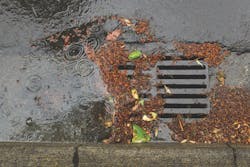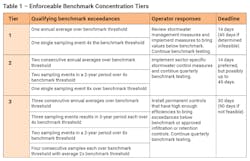About the author:
Bill Carrig, P.M.P., is an environmental consultant in the Iowa City office of Stanley Consultants. Carrig can be reached at [email protected].
Industrial producers who have not yet complied with the stronger storm water discharge regulations suggested as guidelines by previous versions of the Multi-Sector General Permit may be taken off guard by new permit requirements as states incorporate the new standards. The purpose of the regulation is to ultimately minimize pollutant discharges in storm water from industrial activity, according to the U.S. EPA.
As with most environmental regulations, nothing is a binary “either-or” situation. EPA is quick to point out that not all requirements will apply to every facility, and even if they do, they might not apply all the time. For instance, the permit requirements would not apply to materials and activities that are protected by a storm-resistant shelter or roof. There are nuances to what is or is not considered a regulated activity.
Operators of industrial facilities should scrutinize their situation through the lens of new, tougher standards on the way. The good news is the industry may be able to take smaller steps now to improve storm water management and possibly avoid major expenses later, such as building a new storm water treatment facility.
Better Defined Enforcement
On January 15, 2021, the EPA issued the final 2021 Multi-Sector General Permit (MSGP) for a smattering of U.S. territories, such as Guam and other islands, Puerto Rico, the state of New Mexico, Idaho, New Hampshire, Massachusetts, Washington D.C. and federal facilities in Washington state, Colorado and Delaware. The new requirements will become effective March 1, with facilities required to re-submit a Notice of Intent for coverage by May 30, 2021. This also covers oil and gas properties in Texas and Oklahoma.
The 2015 permit rule that has been in effect has benchmark requirements, but they are not enforceable. The proposed 2021 changes make many of the 2015 suggested maximum pollutant concentrations fully enforceable.
EPA intends to apply more rigorous enforcement to these standards based on the numerical benchmarks. Previously, individual enforcement varied depending on the location and situation. A major change with the 2021 permit is that enforcement is better defined.
After this initial rollout, individual states will incorporate EPA guidelines, which is when most facilities will begin to be affected. The time frame for state environmental agencies to adopt new regulations varies. Some may act quickly, but the majority will see the new requirements added as part of their next storm water permit coverage cycle. This corresponds to a three- to seven-year horizon in most cases.
Storm water permitting requirements, as many other regulations, vary greatly from state to state. For example, Iowa has not adopted the benchmark sampling requirements from the 2015 MSGP yet, while California has had enforceable storm water benchmarks for several years. The EPA says that in a recent evaluation of 41 states, 12 states are substantially similar to its regulations, eight are substantially different and 21 are split.
The consensus among industry professionals is that it is just a matter of time before the 2021 MSGP requirements are in effect nationwide. While the changes may be minor or major depending on the location of a facility, operators who analyze the regulations now will get a head start on what is coming.
What is in the New Regulation?
Some of the more significant changes in the 2021 MSGP include:
- Under a new rule, regulated facilities that plan on using coal tar paving sealants would have to eliminate the storm water discharges from the surface, switch to an alternative sealant, or apply for an individual permit.
- Facilities at risk for extreme flooding conditions would be required to consider enhanced runoff control measures. For example, elevating materials, temporarily reducing outdoor storage or delaying deliveries.
- All industry sectors will now perform benchmark monitoring for pH, total suspended solids (TSS) and chemical oxygen demand (COD) quarterly. This is a significant change, since many of the sectors in the 2015 MSGP did not have specific criteria.
- Some sectors, such as oil and gas, land transportation and shipbuilding will have newly added pollutant benchmarks. Changes to benchmark values reflect changes in surface water quality standards. This also includes alternative compliance methods for some metals, such as copper.
- Three-tiered enforcement when there are benchmark exceedances in a facility’s storm water samples. The enforcement will vary greatly depending on the magnitude and frequency of the exceedances.
Of these changes, the one with the most potential to impact many operations and financial bottom lines is tiered enforcement.
How Will Enforcement Work?
The 2015 MSGP indicates that if a benchmark concentration is exceeded, the facility must review control measures to see if modifications are necessary and continue monitoring. These requirements are vague, and facilities can often make a successful argument that it is not financially feasible to meet the suggested criteria. The proposed 2021 MSGP changes would make these benchmarks more enforceable.
Depending on the frequency and severity of benchmark exceedances, one of the compliance tiers in Table 1 (see above) may apply.
For example, an operator needs to implement a measure in 14 days, unless doing so within 14 days is infeasible. If doing so within 14 days is infeasible, one must document per Part 5.3 why it is infeasible and implement such modifications within 45 days. If this continues for 3 years, the operator gets 30- to 90 days to install a permanent control. So, Tier 1 responses can take many forms. It does not have to be a sector-specific BMP or a permanent control. Tiers 2 and 3 can go longer than 45 days, but one will need a well laid out reason and agency approval.
These proposed changes could have a major impact on covered industrial facilities when implemented at the state level, which is just a matter of time. For example, if a facility is in Tier 3, it would be required to design and install a potentially costly permanent solution.
Tier 3 enforcement is likely for some industry sectors due to stringent benchmark criteria. For instance, facilities which fall into Sector U – Food and Kindred Products, Sector AA – Fabricated Metal Products, multiple subsectors of Sector C – Chemicals and Allied Products, and other Subsectors related to mining and quarry operations will have to meet a benchmark of 0.68 mg/L for nitrate plus nitrite nitrogen.
This can be extremely difficult to meet for facilities with outdoor material handling, especially facilities such as grain mills. Locations with significant rodent or bird populations may have issues complying with this criterion, even if facility operations do not have obvious sources of these compounds.
To stay ahead of these regulations and avoid larger costs in the future, facilities subject to these regulations should evaluate their storm water data and determine if storm water benchmark values are routinely being exceeded and by how much. These new regulations may not be new to operators in California, but in other locations, such as in many Midwest states, operators may be in for an unpleasant surprise.
With the potentially costly requirements that come with higher compliance tiers, facilities can begin now to start taking steps beyond basic housekeeping to move towards benchmark compliance. The most important first additional step to be taken should be additional runoff sampling to pinpoint high concentration source areas. It is the first step to the winning formula: prepare, get covered, take action and follow up.

